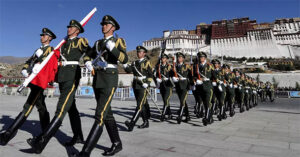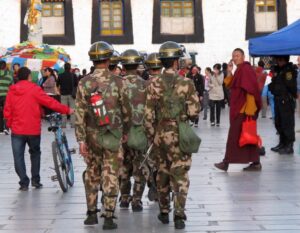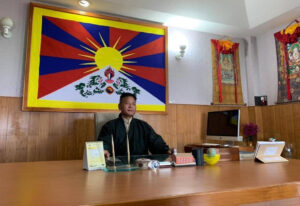
Chinese army marching infront of Potala Palace in Lhasa, Tibet
The release of a White Paper by the Chinese government entitled Tibet Since 1951: Liberation, Development and Prosperity has triggered another round of mudslinging between the Chinese Communist Party (CCP) and the Tibetan Government-in-Exile.
The White Paper was released to coincide with the 70th anniversary of the signing of the 17-point agreement in May 1951 that effectively ceded Tibet to Communist China and seeks to “counter the propaganda spread by a number of Western countries and their allies and provide the international community with a balanced account” of what has occurred in Tibet since.
The report includes the usual Chinese talking points:
- Tibet was a part of China since ancient times.
- The Dalai Lama is an imperialist stooge in the pocket of the United States.
- The Chinese Communists liberated Tibetans from serfdom or slavery.
It also lists achievements since the “liberation” such as:
- Former serfs and slaves granted 186,700 hectares of land in the reforms of the 1960s.
- An increase in GDP from RMB 129 million in 1951 to RMB 190 billion in 2020.
- The construction of 118,800 kilometres of road, railway lines, airports and broadband infrastructure.
- The establishment of 7 institutions of higher learning, 12 secondary vocational schools, 143 middle schools and 827 primary schools.
In reference to the resettlement of nomads the report notes that 266,000 people have been resettled in the interests of their own economic interests and that this was “a rational solution to lift them out of poverty.”
It also claims that:
- absolute poverty in Tibet was eradicated in 2019 for the first time in history.
- Tibet’s ecosytems are now “generally stable”.
- Tibetan culture is in good shape (with reference to a song called Another Folk Song Dedicated to the Party as proof).
- medical infrastructure in the region is adequate (4.9 hospital beds and 5.89 medical workers per thousand people).
 All of the unrest in Tibet over the years is written off as a product of imperialist machinations, with reference to The CIA’s Secret War in Tibet – a book published in 2000, written by Kenneth Conboy and Dale Andrade. The Dalai Lama’s Middle Way proposal is described as being “counter to the fundamental interests of all the people of China, including Tibetans.”
All of the unrest in Tibet over the years is written off as a product of imperialist machinations, with reference to The CIA’s Secret War in Tibet – a book published in 2000, written by Kenneth Conboy and Dale Andrade. The Dalai Lama’s Middle Way proposal is described as being “counter to the fundamental interests of all the people of China, including Tibetans.”
The White Paper concludes with some flowery language about Tibetans enjoying a brighter future guided by Xi Jinping Thought on Socialism with Chinese Characteristics.
In its own statement to mark the 70th anniversary the Tibetan Parliament-in-Exile (TPiE) countered China’s assertion that Tibet had been a part of China since ancient times, instead insisting that Tibet was independent from the second century BC right up until the Communist invasion. Contradicting Chinese claims of development in the region, the TPiE criticised China’s rule as one of “unparalleled violent repression, destruction, killing and assimilation.”

Sikyong elect Penpa Tsering
Newly elected Sikyong Penpa Tsering also responded to the claims made in the White Paper. Minutes after taking the oath as Sikyong on May 27, Tsering said, “All I can say today is that we are open to sending people to Lhasa to verify all the claims.” Tsering went on to say that he was eager to reach out to the Chinese government to find a “mutually beneficial, negotiated, non-violent solution to the Sino-Tibetan conflict.”




 Print
Print Email
Email